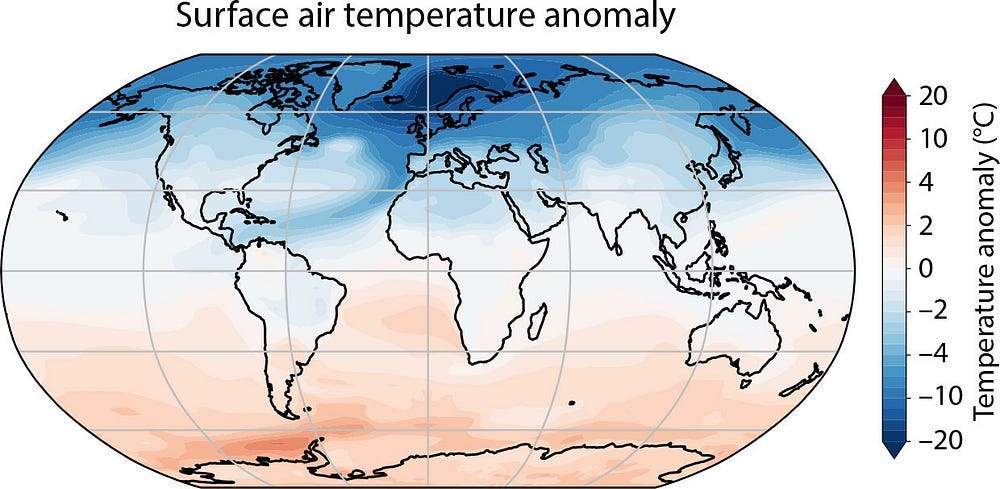When Climate Change Meets Atlantic Collapse — My Homeland Plunges into Ice Age
Warming. Cooling. AMOC collapse. What if it all hits at once?
It all started with a bucket and a rope. Captain Henry Ellis, an English slave trader sweating under the brutal Caribbean sun, dropped Reverend Hales’s “sea-gauge” into the deep. A rudimentary device, drifting in the subtropical Atlantic in 1751, lowered not out of scientific pursuit but colonial convenience. Using a simple rope and valve system, he hauled water from the ocean’s depths to the deck, where a built-in thermometer revealed its temperature.
The sea looked warm. It felt warm. But the water he pulled up from nearly a mile down came out bone cold. As if the rope had been dropped into a buried memory.
“The cold increased regularly, in proportion to the depths, till it descended to 3900 feet: from whence the mercury in the thermometer came up at 11.6°C (53°F); and tho’ I afterwards sunk it to the depth of 5346 feet, that is a mile and 66 feet, it came up no lower.”
These measurements marked humanity’s first glimpse into the deep ocean’s temperatures. They unveiled a startling truth about our world’s waters: no matter how long the sun beats down, the depths stay stubbornly cold and resist warming, even across centuries. Think of a swimming pool in summer. While the surface warms up nicely under the sun, dive down to the bottom and you’ll feel that familiar cold shock. Now imagine that same principle, but on an ocean scale. It’s like having an eternal ice box beneath a sun-warmed blanket.
Ellis thought he had found a luxury: “This experiment, which seemed at first but mere food for curiosity,” he wrote in a letter, “became in the interim very useful to us. By its means we supplied our cold bath, and cooled our wines or water at pleasure; which is vastly agreeable to us in this burning climate.”
He wasn’t wrong — but he was staring at something far larger than comfort.
He had stumbled on the first clue to a planetary circulatory system. What we now call the Atlantic Meridional Overturning Circulation — or AMOC. A deep conveyor belt of water that carries warmth north and cold south, connecting poles to the equator, threading the oceans like a heartbeat.
Nearly half a century later, in 1797, Count Rumford, using Ellis’s “useful” discovery, accurately theorized that only one thing could explain the cold water in the tropics: a system of polar currents cycling through the depths. Cold currents from the poles, moving silently beneath the tropical blaze — a cooling force tempering the excessive heats of these climates.
Today, that system — the AMOC — is breaking.
And this isn’t academic. It’s personal. I grew up not far from where Scandinavia begins to break into tundra, where the Gulf Stream’s northbound warmth makes life marginally survivable. If that warmth stops coming, places like my homeland in the Swedish Lapland won’t just freeze. They will become uninhabitable.
Temperatures could plummet by 10, 20, even 30°C in a matter of decades. And that’s not a poetic winter. Not skiing in the cold. Collapse cold. Frostbite-before-dawn cold. Cold that shatters steel, explodes pipes, and essentially, turns life from difficult to impossible.
What Ellis thought was novelty has become prophecy. And what we’re facing now is a paradox: What if the AMOC collapses, right in the middle of global warming? Freezer or frying pan ahead?
A thought experiment once mistaken for a cooling bath is now a probability curve.

A Planetary Plumbing Problem
You won’t see it from your beach towel in Florida or from the cargo ships slicing across the Atlantic. But beneath the oil freighters, the floating patches of plastic, and cruise ships selling sunsets, the Atlantic branch of the global overturning circulation is quite literally holding Earth’s climate together.
Keep reading with a 7-day free trial
Subscribe to Antarctic Sapiens 🇦🇶 to keep reading this post and get 7 days of free access to the full post archives.







